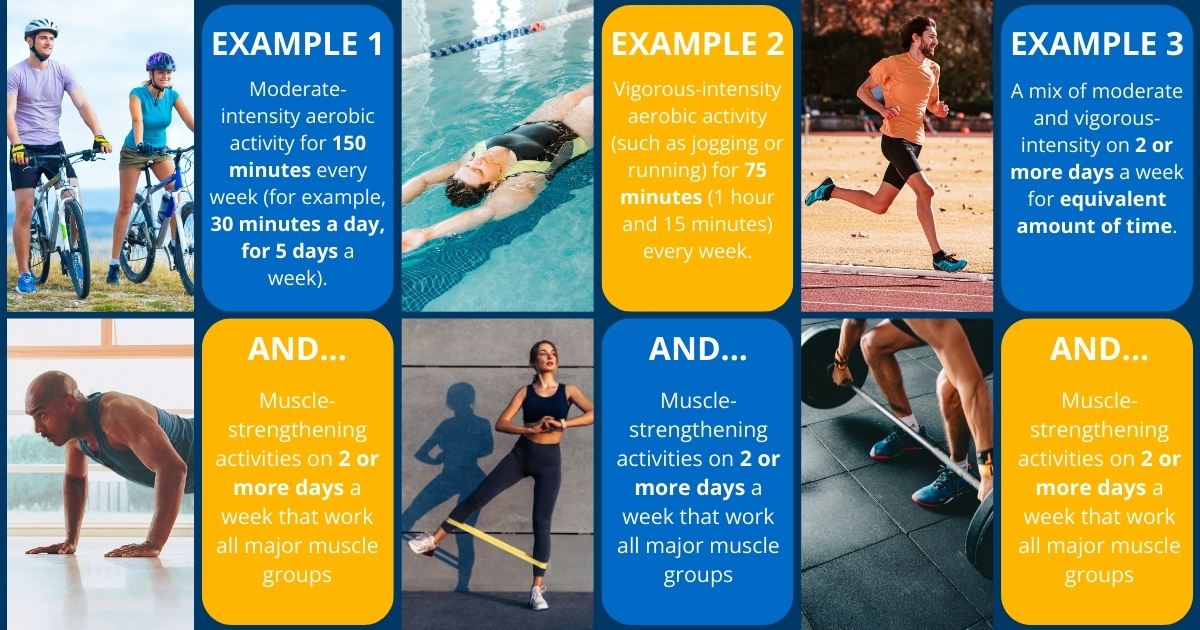How Much Physical Activity Do Adults Need Per Week?

Physical activity is a cornerstone of adult health and well-being. It’s not just about looking good; it’s about feeling great and maintaining optimal health throughout our lives. Healthcare professionals usually recommend 150 minutes of exercise per week, but there’s some flexibility to this rule.
Recommended Exercise Per Week
Some activity is always better than none. Being physically active during the day can contribute to our overall health and well-being. But in order to get substantial health benefits, adults need to dedicate some time per week to aerobic physical activity. The guidelines are as follows:
Moderate-Intensity Physical Activity
Moderate-intensity activities are those that get your heart pumping and your breathing a bit faster, but still allow you to carry on a conversation. Think brisk walking, leisurely cycling, or even gardening. The recommended duration for these activities is 150-300 minutes per week (2 hours and 30 minutes up to 5 hours a week).
Vigorous-Intensity Physical Activity
Vigorous-intensity activities get your heart racing and make it difficult to say more than a few words without pausing for breath. Running, swimming laps, or high-intensity interval training (HIIT) fall into this category. The recommended duration for vigorous activities is 75-150 minutes per week. With vigorous exercise, you can achieve similar health benefits in less time compared to moderate-intensity activities though they are more physically taxing.
Combining Moderate and Vigorous Activities
You don’t have to stick to just one intensity level. In fact, mixing it up can make your routine more enjoyable and sustainable. You could do a couple of vigorous workout sessions and fill the rest of your week with moderate activities. The key is to find a balance that works for you and fits into your lifestyle.
How To Do 150 Minutes of Exercise Per Week
Doing 150 minutes of exercise each week might sound like a lot, but when spread throughout the week, it’s quite manageable. For instance, you could aim for 30 minutes of activity five days a week, or break it down into smaller 10-15 minute sessions throughout each day.
If 150 seems overwhelming, you can start with a smaller goal (like 50 minutes) and gradually increase your activity level over time.
Muscle-Strengthening Exercises Required
While cardio activities are crucial, we shouldn’t forget about strength training. Muscle-strengthening exercises are important for maintaining muscle mass, bone density, and overall functional fitness.
Aim to engage in strength training activities at least 2 days per week. This could include bodyweight exercises like push-ups and squats, using resistance bands, or lifting weights.
Benefits of Weekly Physical Activity
Short-term Benefits
Regular physical activity can provide immediate benefits in the first few weeks. You might notice improved mood and energy levels, better sleep quality, and enhanced cognitive function. These short-term benefits can be powerful motivators to keep you moving.
Long-term Health Benefits
Over time, consistent physical activity can lead to significant long-term health benefits. These include reduced risk of chronic diseases such as heart disease, type 2 diabetes, and certain cancers. Regular exercise also improves cardiovascular health and aids in better weight management.
Tailoring Physical Activity to Individual Needs
Age Considerations
While the general recommendations apply to all adults, it’s important to consider age-specific needs. Adults aged 18-64 might focus on a mix of cardio and strength training, while older adults (65+ years) might prioritize activities that improve balance and flexibility to prevent falls.
Health Considerations
If you are recovering from an injury, dealing with chronic pain or managing a health condition that impacts your physical fitness and mobility, you will need to adapt these recommendations to your individual needs. This might involve modified exercises or different types of activities that are safe and effective for your condition.
A Physical therapist can help you develop an individualized exercise program that caters to your specific needs. Even if you’re not experiencing pain, physical therapy can enhance strength, balance, and overall wellness.
Get Active With Physical Therapy
Physical Therapy As Part of Your Weekly Exercise Routine
Does Physical Therapy Count as Exercise?
Physical therapy uses a range of activities that align with the goals and recommended levels of physical activity. If you are looking to build an exercise routine, physical therapy exercises are a great way to start. They include:
Aerobic and Endurance Conditioning: Activities that improve cardiovascular fitness.
Strengthening Exercises: Focused on building muscle strength through resistance training.
Flexibility and Stretching: Aimed at improving range of motion and preventing stiffness.
Balance and Coordination: Exercises that enhance stability and prevent falls.
How Often Should I Do Physical Therapy Exercises?
Many physical therapy exercises should be performed daily or up to three times a day, especially if they are low-intensity and focused on mobility or flexibility. This helps maintain consistency and promotes healing.
If you are working with a physical therapist, ask them about the recommended frequency. If you are working out on your own, stick to the general recommendation but listen to your body and stop if you are feeling too tired. Remember you should not feel in pain while you exercise, and stop if you do.
For strengthening exercises targeting specific body areas, it’s often recommended to perform them 2 to 3 times a week on non-consecutive days. This allows for adequate recovery between sessions.
